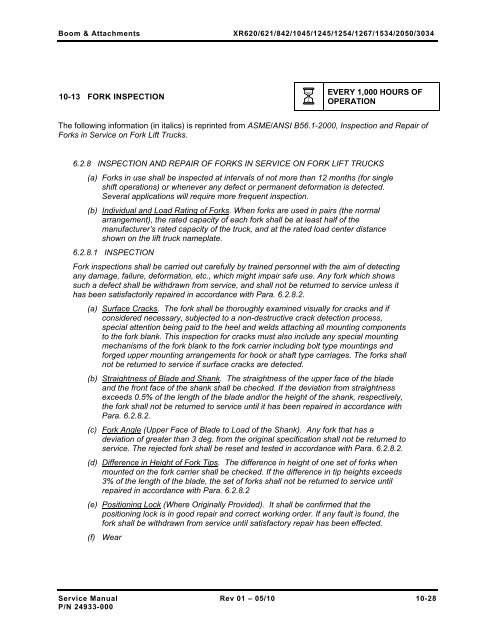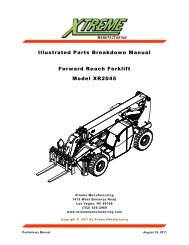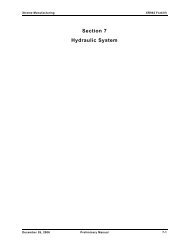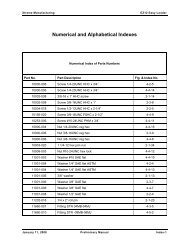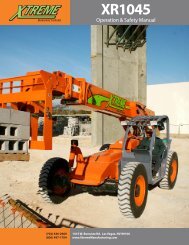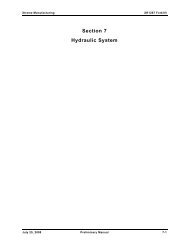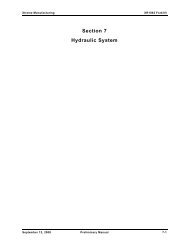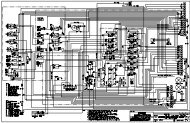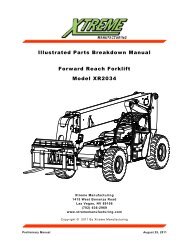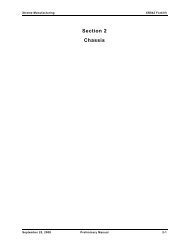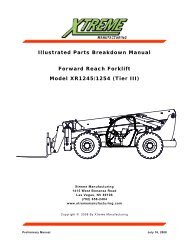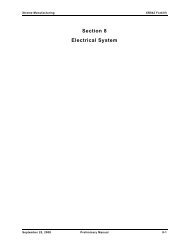- Page 1 and 2:
Service ManualForward Reach Forklif
- Page 3 and 4:
List of Effective PagesXR620/621/84
- Page 5 and 6:
Table of ContentsXR620/621/842/1045
- Page 7:
Table of ContentsXR620/621/842/1045
- Page 12 and 13:
Table of ContentsXR620/621/842/1045
- Page 14 and 15:
Table of ContentsXR620/621/842/1045
- Page 16 and 17:
General Information & Specification
- Page 18 and 19:
General Information & Specification
- Page 20 and 21:
General Information & Specification
- Page 22 and 23:
General Information & Specification
- Page 24 and 25:
General Information & Specification
- Page 26 and 27:
General Information & Specification
- Page 28:
General Information & Specification
- Page 31 and 32:
General Information & Specification
- Page 33 and 34:
General Information & Specification
- Page 35 and 36:
General Information & Specification
- Page 37 and 38:
General Information & Specification
- Page 39 and 40:
General Information & Specification
- Page 41 and 42:
General Information & Specification
- Page 43 and 44:
General Information & Specification
- Page 45 and 46:
General Information & Specification
- Page 47 and 48:
Maintenance & Operation SafetyXR620
- Page 49 and 50:
Maintenance & Operation SafetyXR620
- Page 51 and 52:
Maintenance & Operation SafetyXR620
- Page 53 and 54:
Maintenance & Operation SafetyXR620
- Page 55 and 56:
Maintenance & Operation SafetyXR620
- Page 57 and 58:
Maintenance & Operation SafetyXR620
- Page 59 and 60:
Maintenance & Operation SafetyXR620
- Page 61 and 62:
Maintenance & Operation SafetyXR620
- Page 63 and 64:
Maintenance & Operation SafetyXR620
- Page 65 and 66:
Maintenance & Operation SafetyXR620
- Page 67 and 68:
Maintenance & Operation SafetyXR620
- Page 69 and 70:
Maintenance ScheduleXR620/621/842/1
- Page 71 and 72:
Maintenance ScheduleXR620/621/842/1
- Page 73 and 74:
Maintenance ScheduleXR620/621/842/1
- Page 75 and 76:
Axle Cylinder & Outrigger Lubricati
- Page 77 and 78:
Axle Cylinder & Outrigger Lubricati
- Page 79 and 80:
Axle Cylinder & Outrigger Lubricati
- Page 81 and 82:
EngineXR620/621/842/1045/1245/1254/
- Page 83 and 84:
EngineXR620/621/842/1045/1245/1254/
- Page 85 and 86:
EngineXR620/621/842/1045/1245/1254/
- Page 87 and 88:
EngineXR620/621/842/1045/1245/1254/
- Page 89 and 90:
EngineXR620/621/842/1045/1245/1254/
- Page 91 and 92:
EngineXR620/621/842/1045/1245/1254/
- Page 93 and 94:
EngineXR620/621/842/1045/1245/1254/
- Page 95 and 96:
EngineXR620/621/842/1045/1245/1254/
- Page 97 and 98:
EngineXR620/621/842/1045/1245/1254/
- Page 99 and 100:
EngineXR620/621/842/1045/1245/1254/
- Page 101 and 102:
EngineXR620/621/842/1045/1245/1254/
- Page 103 and 104:
EngineXR620/621/842/1045/1245/1254/
- Page 105 and 106:
EngineXR620/621/842/1045/1245/1254/
- Page 107 and 108:
EngineXR620/621/842/1045/1245/1254/
- Page 109 and 110:
EngineXR620/621/842/1045/1245/1254/
- Page 111 and 112:
EngineXR620/621/842/1045/1245/1254/
- Page 113 and 114:
EngineXR620/621/842/1045/1245/1254/
- Page 115 and 116:
Transmission, Axles & DriveshaftsXR
- Page 117 and 118:
Transmission, Axles & DriveshaftsXR
- Page 119 and 120:
Transmission, Axles & DriveshaftsXR
- Page 121 and 122:
Transmission, Axles & DriveshaftsXR
- Page 123 and 124:
Transmission, Axles & DriveshaftsXR
- Page 125 and 126:
Transmission, Axles & DriveshaftsXR
- Page 127 and 128:
Transmission, Axles & DriveshaftsXR
- Page 129 and 130:
Wheels & TiresXR620/621/842/1045/12
- Page 131 and 132:
Wheels & TiresXR620/621/842/1045/12
- Page 133 and 134:
Wheels & TiresXR620/621/842/1045/12
- Page 135 and 136:
Wheels & TiresXR620/621/842/1045/12
- Page 137 and 138:
Hydraulic SystemXR620/621/842/1045/
- Page 139 and 140:
Hydraulic SystemXR620/621/842/1045/
- Page 141 and 142:
Hydraulic SystemXR620/621/842/1045/
- Page 143 and 144:
Hydraulic SystemXR620/621/842/1045/
- Page 145 and 146:
Hydraulic SystemXR620/621/842/1045/
- Page 147 and 148:
Hydraulic SystemXR620/621/842/1045/
- Page 149 and 150:
Hydraulic SystemXR620/621/842/1045/
- Page 151 and 152:
Hydraulic SystemXR620/621/842/1045/
- Page 153 and 154:
Hydraulic SystemXR620/621/842/1045/
- Page 155 and 156:
Hydraulic SystemXR620/621/842/1045/
- Page 157 and 158:
Hydraulic SystemXR620/621/842/1045/
- Page 159 and 160:
Hydraulic SystemXR620/621/842/1045/
- Page 161 and 162:
Hydraulic SystemXR620/621/842/1045/
- Page 163 and 164:
Hydraulic SystemXR620/621/842/1045/
- Page 165 and 166:
Hydraulic SystemXR620/621/842/1045/
- Page 167 and 168:
Hydraulic SystemXR620/621/842/1045/
- Page 169 and 170:
Hydraulic SystemXR620/621/842/1045/
- Page 171 and 172:
Hydraulic SystemXR620/621/842/1045/
- Page 173 and 174:
Hydraulic SystemXR620/621/842/1045/
- Page 175 and 176:
Hydraulic SystemXR620/621/842/1045/
- Page 177 and 178:
Hydraulic SystemXR620/621/842/1045/
- Page 179 and 180:
Hydraulic SystemXR620/621/842/1045/
- Page 181 and 182:
Hydraulic SystemXR620/621/842/1045/
- Page 183 and 184: Hydraulic SystemXR620/621/842/1045/
- Page 185 and 186: Electrical SystemXR620/621/842/1045
- Page 187 and 188: Electrical SystemXR620/621/842/1045
- Page 189 and 190: Electrical SystemXR620/621/842/1045
- Page 191 and 192: Electrical SystemXR620/621/842/1045
- Page 193 and 194: Electrical SystemXR620/621/842/1045
- Page 195 and 196: Electrical SystemXR620/621/842/1045
- Page 197 and 198: Electrical SystemXR620/621/842/1045
- Page 199 and 200: Electrical SystemXR620/621/842/1045
- Page 201 and 202: Electrical SystemXR620/621/842/1045
- Page 203 and 204: Electrical SystemXR620/621/842/1045
- Page 205 and 206: Electrical SystemXR620/621/842/1045
- Page 207 and 208: Boom & AttachmentsXR620/621/842/104
- Page 209 and 210: Boom & AttachmentsXR620/621/842/104
- Page 211 and 212: Boom & AttachmentsXR620/621/842/104
- Page 213 and 214: Boom & AttachmentsXR620/621/842/104
- Page 215 and 216: Boom & AttachmentsXR620/621/842/104
- Page 217 and 218: Boom & AttachmentsXR620/621/842/104
- Page 219 and 220: Boom & AttachmentsXR620/621/842/104
- Page 221 and 222: Boom & AttachmentsXR620/621/842/104
- Page 223 and 224: Boom & AttachmentsXR620/621/842/104
- Page 225 and 226: Boom & AttachmentsXR620/621/842/104
- Page 227 and 228: Boom & AttachmentsXR620/621/842/104
- Page 229 and 230: Boom & AttachmentsXR620/621/842/104
- Page 231 and 232: Boom & AttachmentsXR620/621/842/104
- Page 233: Boom & AttachmentsXR620/621/842/104
- Page 237 and 238: Boom & AttachmentsXR620/621/842/104
- Page 239 and 240: Checkout ProceduresXR620/621/842/10
- Page 241 and 242: Checkout ProceduresXR620/621/842/10
- Page 243 and 244: Checkout ProceduresXR620/621/842/10
- Page 245 and 246: Storage & TransportationXR620/621/8
- Page 247 and 248: Storage & TransportationXR620/621/8
- Page 249 and 250: Storage & TransportationXR620/621/8
- Page 251 and 252: IndexXR620/621/842/1045/1245/1254/1
- Page 253 and 254: IndexXR620/621/842/1045/1245/1254/1
- Page 255 and 256: IndexXR620/621/842/1045/1245/1254/1
- Page 257 and 258: Maintenance Forms & Safety TagsXR62
- Page 259 and 260: AFTER FIRST 50 HOURS OF OPERATIONRE
- Page 261 and 262: AFTER EVERY 500 HOURS OF OPERATIONR
- Page 263 and 264: AFTER EVERY 2,000 HOURS OF OPERATIO
- Page 265 and 266: Maintenance History LogFORKLIFT MOD
- Page 267 and 268: Fork Inspection LogFORKLIFT MODEL:
- Page 269 and 270: Pre-Operation Checklist Operate the
- Page 271 and 272: Grease Fittings ListComponent No. o
- Page 273 and 274: A-17
- Page 275 and 276: NotesA-19
- Page 277: ContactXtreme Manufacturing, LLC141


